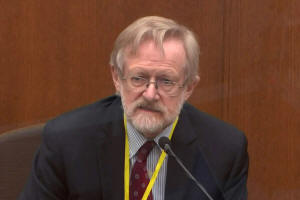Doctors challenge 'drug overdose' defense in Derek Chauvin's murder
trial
 Send a link to a friend
Send a link to a friend
 [April 09, 2021]
By Jonathan Allen [April 09, 2021]
By Jonathan Allen
MINNEAPOLIS (Reuters) -Medical experts used
anatomical diagrams and charts to testify on Thursday that George Floyd
was killed by police pinning him to the ground, not a drug overdose,
challenging a key assertion by former police officer Derek Chauvin in
his murder trial for Floyd's deadly arrest.
Dr. Martin Tobin, who treats patients in a Chicago hospital's intensive
care unit, told the jury that Floyd died "from a low level of oxygen"
caused by being handcuffed face down in the street with the police
officer's knee on his neck. Video of the arrest last May sparked global
protests.
Jurors touched various parts of their necks under Tobin's guidance as
the doctor gave impromptu anatomy lessons from the stand. Any "healthy
person," he said, would have died in a similar restraint, which he
compared to a vise, supporting the county medical examiner's finding
that Floyd's death was a homicide at the hands of police.

Dr. Daniel Isenschmid said the toxicology tests he performed on Floyd's
blood on behalf of the medical examiner found fentanyl, but at a level
comparable to those found in samples taken from living people detained
for driving under the influence of narcotics.
Dr. William Smock, a forensic pathologist who works with police, told
the jury that Floyd died of "positional asphyxia" from the police holds,
"which is a fancy way of saying he died because he had no oxygen left in
his body," he said.
Video of the arrest showed Chauvin, who is white, pinning Floyd's neck
to the ground with his knees for more than nine minutes as Floyd, a
46-year-old Black man, begged for his life, gasping more than two dozen
times: "I can't breathe." Chauvin has pleaded not guilty to murder and
manslaughter charges.
All three doctors called by prosecutors from the Minnesota Attorney
General's Office pointed to different moments from the video that they
said undermined Chauvin's defense.
Tobin said Floyd's breathing became fatally shallow under the police
restraint, but asked jurors to count along with him as they watched
body-worn camera video of the dying Floyd's torso, showing that the
number of breaths he took per minute did not decrease up until the
moment he lost consciousness.

A fentanyl overdose, in contrast, is marked by a sharp decrease in the
frequency of breaths, he said.
The doctor also unbuttoned his shirt collar and began to feel parts of
his neck, as he described how Chauvin's knee compressed the delicate
tissue of the hypopharynx, blocking that part of the respiratory system
in the lower part of the throat.
Eric Nelson, Chauvin's lead lawyer, objected to the hands-on anatomy
lessons. Hennepin County District Judge Peter Cahill overruled the
objection, but told jurors it was up to them whether they wanted to
follow along with Tobin in feeling their own throats. Most continued to
do so.
[to top of second column]
|

Chicago-based breathing expert Dr. Martin Tobin answers questions
during the ninth day of the trial of former Minneapolis police
officer Derek Chauvin for second-degree murder, third-degree murder
and second-degree manslaughter in the death of George Floyd in
Minneapolis, Minnesota, U.S. April 8, 2021 in a still image from
video. Pool via REUTERS

'DEADLY MANTRA'
Tobin calculated that at times, Chauvin, who suspected Floyd of
passing a fake $20 bill, was exerting 91.5 pounds (41.5 kg) of
downward pressure on Floyd's neck.
In cross-examination, Nelson asked Tobin if he had personally
weighed Chauvin, who in police reports is recorded as 140 pounds (64
kg), or Chauvin's equipment in order to calculate the pressure
applied by his knee. Tobin said he had not.
Tobin discussed frames from the video that he said showed Floyd
trying to push his chest up from the street using his fingers and
his face as leverage as he struggled for breath beneath Chauvin and
two other officers.
"They're pushing the handcuffs into his back and pushing them high,
then on the other side you have the street. The street is playing
the crucial part," Tobin said. "It's like the left side is in a
vise."
Chauvin can be heard on video dismissing Floyd's pleas, saying: "It
takes a heck of a lot of oxygen to say things."
Tobin called that a "dangerous mantra."
"It's a true statement, but it gives you an enormous false sense of
security," Tobin said. "Certainly at the moment you're speaking, you
are breathing, but it doesn't tell you if you're going to be
breathing five seconds later."

Tobin said Floyd's leg could be seen jumping up in an involuntary
seizure as his brain was starved of oxygen.
Soon after, Tobin said, the moment came when Floyd did not have even
"an ounce of oxygen left in his entire body," although Chauvin's
knee stayed on Floyd's neck for three more minutes.
Isenschmid, the toxicologist, compiled data on samples taken from
2,345 people stopped for driving under the influence in 2020, noting
that people addicted to opioids need to take higher doses as
tolerance builds up. The mean average level of fentanyl found in the
blood of those people, all of whom were alive, was 9.69 ng/ml,
compared with the 11 ng/ml found in Floyd's blood, he said.
Nelson is expected to call his own medical experts to testify in
Chauvin's defense as soon as next week.
(Reporting by Jonathan Allen in Minneapolis; Editing by Will Dunham
and Peter Cooney)
[© 2021 Thomson Reuters. All rights
reserved.] Copyright 2021 Reuters. All rights reserved. This material may not be published,
broadcast, rewritten or redistributed.
Thompson Reuters is solely responsible for this content.
 |